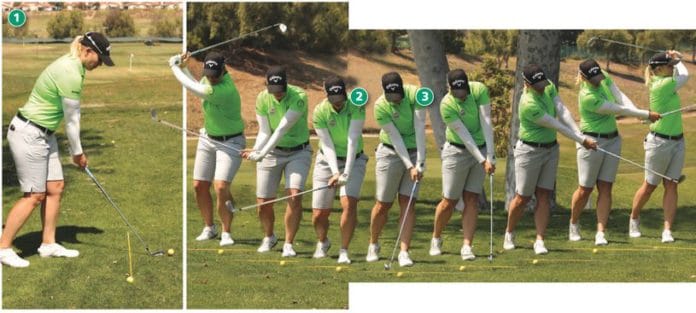Using the ground properly to increase power and distance on shots has become a hot topic in the golf industry. With improvements in technology instructors can know measure how much pressure a golfer puts into the ground in order to maximize efforts. Ground force reaction (GFR) has been discussed, debated, and taught to students who wish to use their legs better in the golf swing. I’ve come up with an easy explanation to help students understand this concept quickly so that their golf game can improve.
The load, squat, jump sequence is an easy way to describe the proper use of the legs to help students use the ground more effectively to improve power and speed. This ultimately translates to more distance for the student.
Recommended Drills
There are two simple drills I prescribe that students can use in order to feel how much leg motion can be utilized in the swing. Players who lack distance and control often over-use their upper body (hands and arms) and unfortunately, this creates more variance in the golf shots. Using larger muscle groups, such as the core, legs, and hips create more reliable sources of motion.
The first drill to practice with is the Single Leg Swing Drill. Line up the golf ball with your lead leg, and pull back your trail leg so the toe in on the ground (See Picture 1). Next, you will make some swings utilizing your legs and upper body (see Pictures 2 & 3).
Most players will start this drill only swinging their upper body. What will happen naturally is the lead knee will flex in the downswing in order to maintain stability and balance. Next, it will begin to straighten, or “post,” right before impact so you’re able to swivel and rotate through. You can pick up clubhead speed with the drill immediately which will solidify the benefits and impact of using the ground quickly.
An easy way to understand how flexing and pushing into the ground creates force in the golf swing is through the use of a jump rope. If you look at the pictures of me demonstrating jumping rope (Picture 4), you’ll see the knees flex right before I jump over the rope. As I leap into the air, the legs extend.
The movement of knee flexion to extension is what creates the force and energy to propel my body into the air. Golfers use this same extension action to create energy and power in the golf swing.
This idea will certainly challenge those who believe you should “keep your head down,” throughout the swing. Over the years we have seen many examples of tour players who squat lower in the downswing, then extend and “jump” through impact and into the finish position. This creates massive gains in power. Look at some of the games longest hitters: Rory McIlroy, Dustin Johnson, Lexi Thompson, and Brittaney Lincicome. Working on these two concepts will help you solidify the idea of ground reaction forces, and simplify how to use your legs in the swing to maximize power.
The post How to Build Speed and Power into your Swing appeared first on Women's Golf.

